Hyundai Tucson: Rear seats
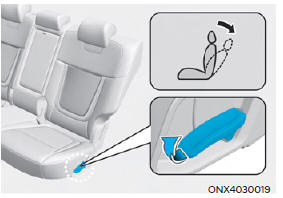
Seatback angle
To recline the seatback:
- Pull up the seatback recline lever.
- Hold the lever and adjust the seatback of the seat to the position you desire.
- Release the lever and make sure the seatback is locked in place. (The lever MUST return to its original position for the seatback to lock.)
Folding the rear seat
The rear seatbacks can be folded to facilitate carrying long items or to increase the luggage capacity of the vehicle.
WARNING
- Never allow passengers to sit on top of the folded down seatback while the vehicle is moving. This is not a proper seating position and no seat belts are available for use. This could result in serious injury or death in case of an accident or sudden stop.
- Objects carried on the folded down
seatback should not extend higher
than the top of the front seatbacks.
This could allow cargo to slide forward and cause injury or damage during sudden stops.

To fold down the rear seatback:
- Set the front seatback to the upright position and if necessary, slide the front seat forward.
- Lower the rear headrests to the lowest position by pushing and holding the release button (1) and pushing down on the headrest (2).


- Insert the rear seat belt buckle in the pocket between the rear seatback and cushion, and insert the rear seat belt webbing in the guide to prevent the seat belt from being damaged.
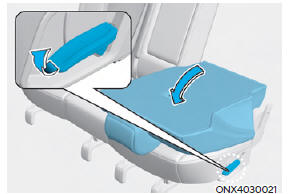
- Pull up the seatback folding lever, then fold the seat toward the front of the vehicle.
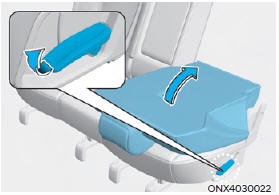
- To use the rear seat, lift and push
the seatback rearward by lifting up
the front portion of the folding lever.
Push the seatback firmly until it clicks into place. Make sure the seatback is locked in place.
WARNING
When returning the rear seatback from a folded to an upright position, hold the seatback and return it slowly. Ensure that the seatback is completely locked into its upright position by pushing on the top of the seatback. In an accident or sudden stop, the unlocked seatback could allow cargo to move forward with great force and enter the passenger compartment, which could result in serious injury or death.
WARNING
Make sure the engine is off, the shift lever is in P (Park), and the parking brake is securely applied whenever loading or unloading cargo. Failure to take these steps may allow the vehicle to move if the shift lever is inadvertently moved to another position.
CAUTION
- Be careful when loading cargo through the rear passenger seats to prevent damage to the vehicle interior.
- When cargo is loaded through the rear passenger seats, ensure the cargo is properly secured to prevent it from moving while driving.
WARNING
Cargo should always be secured to prevent it from being thrown about the vehicle in a collision and causing injury to the vehicle occupants. Do not place objects in the rear seats, since they cannot be properly secured and may hit the front seat occupants in a collision.
Seatback remote folding/unfolding (luggage compartment)


Pull the rear seats back folding lever (1) located in the both sides in the cargo area.
WARNING
Rear seat folding Do not fold the rear seats, if passengers, pets or luggage are in the rear seats.
It may cause injury or damage to passengers, pets and luggage.
Armrest

The armrest is located in the center of the rear seat. Pull the armrest down from the seatback to use it.
Rear occupant alert system (rear seats) (if equipped)
This function alerts the driver when he or she gets out of a car with passengers still remaining in the rear seats.
If the front door is opened while passengers are in the rear seats, a warning message will appear on the cluster panel as a reminder to check to rear seats. If movement is detected in the rear seats after locking all doors, a second warning will alert the driver.
Make sure to check for passengers in the rear seats before leaving the vehicle.
For more information, refer to the "Rear occupant alert system" in chapter 3.
Head Restraints
The vehicle's front and rear (second row and/or third row) seats have adjustable head restraints. The head restraints provide comfort for passengers, but more importantly they are designed to help protect passengers from whiplash and other neck and spinal injuries during an accident, especially in a rear impact collision.
WARNING
To reduce the risk of serious injury or death in an accident, take the following precautions when adjusting your head restraints:
- Always properly adjust the head restraints for all passengers BEFORE starting the vehicle.
- NEVER let anyone ride in a seat with the head restraints removed or reversed.

- Adjust the head restraints so the middle of the head restraints is at the same height as the height of the top of the eyes.
- NEVER adjust the head restraints position of the driver's seat when the vehicle is in motion.
- Adjust the head restraints as close to the passenger's head as possible. Do not use a seat cushion that holds the body away from the seatback.
- Make sure the head restraints locks into position after adjusting it.
WARNING
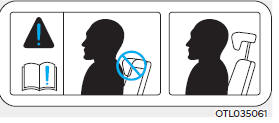 When sitting on the rear
seat, do not
adjust the height of the head restraints
to the lowest position.
When sitting on the rear
seat, do not
adjust the height of the head restraints
to the lowest position.
CAUTION
When there is no occupant in the rear seats, adjust the height of the head restraints to the lowest position. The rear seat head restraints can reduce the visibility of the rear area.
NOTICE
To prevent damage, NEVER hit or pull on the head restraints.
Front seat head restraints
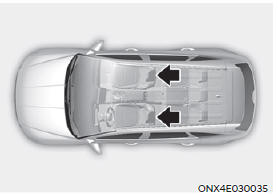
The driver's and front passenger's seats are equipped with adjustable head restraint for the passengers safety and comfort.
Adjusting the height up and down

To raise the head restraint:
- Pull it up to the desired position (1).
To lower the head restraint:
- Push and hold the release button (2) on the head restraint support.
- Lower the head restraint to the desired position (3).
NOTICE
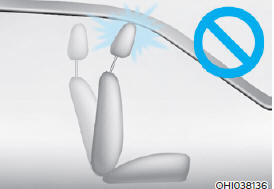 If you recline the seatback
towards the
front with the head restraint and seat
cushion raised, the head restraint may
come in contact with the sunvisor or
other parts of the vehicle.
If you recline the seatback
towards the
front with the head restraint and seat
cushion raised, the head restraint may
come in contact with the sunvisor or
other parts of the vehicle.
Removal/Reinstall

To remove the head restraint:
- Recline the seatback (2) with the seatback angle lever (1).
- Raise the head restraint as far as it can go.
- Press the head restraint release button (3) while pulling the head restraint up (4).
WARNING
NEVER allow anyone to travel in a seat with the head restraint removed.
To reinstall the head restraint :
- Recline the seatback.
- Put the head restraint poles (2) into the holes while pressing the release button (1).
- Adjust the head restraint to the appropriate height.
- Recline the seatback (4) with the seatback angle lever (3).
WARNING
Always make sure the head restraint locks into position after reinstalling and adjusting it properly.
Rear seat head restraint
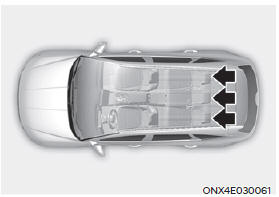
The rear seats are equipped with head restraint in all the seating positions for the passenger's safety and comfort.
Adjusting the height up and down

To raise the head restraint:
- Pull it up to the desired position (1).
To lower the head restraint:
- Push and hold the release button (2) on the head restraint support.
- Lower the head restraint to the desired position (3).
Removal/Reinstallation

To remove the head restraint:
- Raise the head restraint as far as it can go.
- Press the head restraint release button (1) while pulling the headrest up (2).
To reinstall the head restraint:
- Put the head restraint poles into the holes (3) while pressing the release button (1).
- Adjust the head restraint to the appropriate height.
READ NEXT:
 Seat warmers
Seat warmers
Seat warmers are provided to warm the
seats during cold weather.
During mild weather or under conditions
where the operation of the seat warmer
is not needed, keep the seat warmers
OFF.
WARNING
The seat warmers can cause a SERIOUS
BURN, eve
 Air ventilation seat
Air ventilation seat
The air ventilation seats are provided
to cool the front seats by blowing air
through small vent holes on the surface
of the seat cushions and seatbacks.
When the operation of the air ventilation
seat is not needed, keep the switches in
t
 Rear Occupant Alert (ROA)
Rear Occupant Alert (ROA)
Rear Occupant Alert is provided to
prevent a driver from leaving a vehicle
with a rear passenger left in the vehicle.
System setting
To use Rear Occupant Alert, it must be
enabled from the Settings menu in the
infotainment system screen. Select
SEE MORE:
 Connector and Terminal Function
Connector and Terminal Function
Connector Funtion
Removal
Disconnect the negative (-) battery terminal.
Remove the rear bumper assembly.
(Refer to Body - "Rear Bumper Assembly")
Disconnect the rear corner radar connector (A).
Loosen the mounting n
 The MDX-670P Analyzer
The MDX-670P Analyzer
The MDX-670P battery conductance and electrical system analyzer tests
batteries as well as starting and
charging systems for vehicle.
It displays the test results in seconds and features a built-in printer to
provide a copy of the results.
Information
- Home
- Hyundai Tucson - Fourth generation (NX4) - (2020-2023) - Owner's Manual
- Hyundai Tucson - Fourth generation (NX4) - (2020-2023) - Workshop Manual